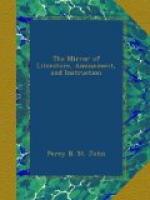THE ISLE OF WIGHT.
[Illustration: (Wilkes’s Cottage.)]
Notes from A pedestrian excursion in the island.
By a Correspondent.
Although the roads of the island have within the last twenty years been rendered passable for vehicles of all kinds, even to stage coaches, yet by far the best mode of inspecting this English Arcadia is to travel through it on foot, commencing at Ryde.
From this town a footpath leads across the park and grounds of St. John’s into the high road which may be followed to Brading. About a mile from that place is Nunwell, the seat of Sir W. Oglander; and opposite is a delightful view of Bembridge (the birthplace of Madame de Feuchares) and Brading Harbour, which at high water presents to the eye a rich, deep, green colour, with an increased effect from being surveyed through the long line of tall elms on the road side. Brading boasts of a mayor and corporation, and formerly sent a member to parliament, which privilege was abolished by Queen Elizabeth. The town is of high antiquity, as is also the church, which tradition says was the first built in the island. It contains few monuments of interest or note, but the surrounding burial-ground can boast of a collection of epitaphs and inscriptions which are above mediocrity. The following to the memory of Miss Barry by the Rev. Mr. Gill has been rendered celebrated by the admirable music of Dr. Calcott:
Forgive, blest shade, the tributary tear,
That mourns thy exit from
a world like this;
Forgive the wish that would have kept
thee here,
And stayed thy progress to
the realms of bliss.
No more confined to grov’ling scenes
of night—
No more a tenant pent in mortal
clay;
Now should we rather hail thy glorious
flight,
And trace thy journey to the
realms of day.
On a rising ground at the end of the town is the Mall; at the entrance of which the earth reverberates to the tread of horses’ feet in a manner similar to that produced by riding over a bridge or hollow. It is most probably occasioned by a natural cleft in the chalk beneath the gravel road. Here the tourist should rest to enjoy a scene of unrivalled beauty. On the left, below the road, lies the town of Brading, and more remote, St. Helen’s Road, and the opposite coasts of Portsmouth and Southsea. In front, at the foot of the hill, are the rich levels, with the sinuous river Yar slowly winding towards the harbour, with the full broad front of Bembridge Down interrupting the marine view, which is again presented on the right from the village of Sandown to the extremity of Shanklin. At the foot of Brading Hill the road divides itself into two branches. The one to the right leads direct to Shanklin, over Morton Common: the other to the left lies through Yarbridge to Yaverland and Sandown. We recommend the latter,




